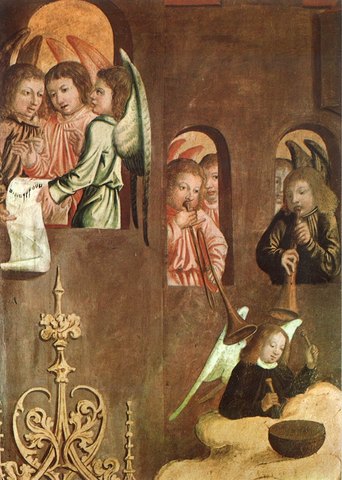J. Body and soul; angels, death and devil

Fig. The Last Judgment (detail). Altar panel from Hall i. T., 1504. Landesmuseum Ferdinandeum, Innsbruck, Inv. no. 85. With permission. The music of the angels, performed at the Last Judgment, takes place in a church. The realistic presentation makes the afterlife appear familiar.
Just how close the affinity between music and mentality was can best be demonstrated by the social practices of music in the late Middle Ages: music acted both as an amplifier and a mediator of individual and collective emotions. The piety of the laity was expressed in part musically, both in the chivalric realm and during pilgrimages and processions. The musical customs of the church (» A. Lay piety: the role of the church) were imitated and sometimes exaggerated in superstitious manners. Devotional songs like In God’s name we go forth (» Hörbsp. ♫ Gottes namen faren wir, Hofhaimer; » Hörbsp. ♫ Ave mundi spes Maria / Gottes namen faren wir) became symbols of a collective and lived-out faith. Theologians and laypeople imagined the music of the angels in both a fantastical and realistic manner which characterizes the musical mentality of the time itself. Apocalyptic visions and physical experiences were intertwined in the musically delineated life of the individual and the community. Music was used to express collective ideas of hate and fear; the othered personages depicted in musical compositions were foreigners: heretics, Jews, Hussites and Turks. It may be that music in such contexts worked in part therapeutically; however, the mocking of Jews in the Passion plays also led to racist caricature and served cynical interests of the powerful.
The texts marked with * are not yet available online.
Formen der Laienfrömmigkeit
Ute Monika SchwobHimmlische und irdische Musik
Wolfgang FuhrmannKörper und Seele*
Birgit LodesAggressionen und Ängste. Judenhass
Andrea HorzAggressionen und Ängste. Türken*
Birgit Lodes